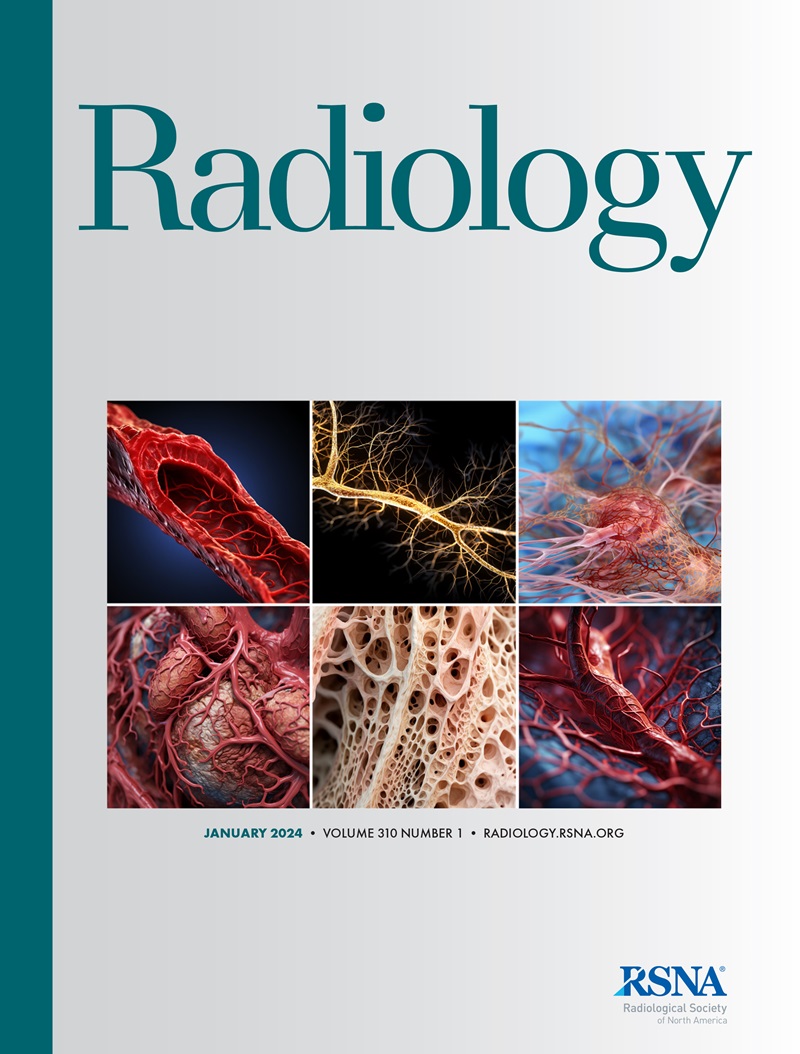解剖学衍生的3D主动脉血流动力学使用流体物理信息深度学习。
IF 12.1
1区 医学
Q1 RADIOLOGY, NUCLEAR MEDICINE & MEDICAL IMAGING
引用次数: 0
摘要
背景四维(4D)血流MRI提供了胸主动脉血流动力学指标的评估,这些指标越来越被认为是风险评估的重要生物标志物。然而,较长的采集时间和繁琐的数据分析限制了广泛的可用性。目的评估生成人工智能(AI)方法(流体物理-知情循环生成对抗网络[FPI-CycleGAN])直接从解剖输入量化主动脉血流动力学的可行性和准确性,作为4D血流MRI的替代方法。材料和方法回顾性地从2011年11月至2020年7月期间进行的临床心胸MRI检查数据集中确定患者。所有患者均行主动脉4D血流MRI检查,作为FPI-CycleGANs训练和检测的参考标准。使用主动脉几何形状的三维(3D)分割作为预测收缩主动脉血流动力学的唯一输入,使用单独的二尖瓣主动脉瓣(BAV)网络(训练集994个,测试集248个)和三尖瓣主动脉瓣(TAV)网络(训练集419个,测试集104个)。采用逐体素和区域分析来量化和比较(AI与参考标准4D血流)收缩速度矢量场、峰值速度、壁剪切应力(WSS)和主动脉瓣狭窄的分类。结果共1765例患者,中位年龄53岁[IQR, 41-63岁];包括1242例BAV患者和523例TAV患者。TAV和BAV网络的平均AI计算时间分别为0.15秒±0.11 (SD),总训练时间分别为1500分钟和3600分钟。FPI-CycleGAN准确预测收缩期三维速度矢量场,偏差低(<0.01 m/sec),一致性极限值高(±0.06-0.08 m/sec)。在峰值流速和WSS方面,FPI-CycleGAN与4D flow具有很强的一致性(r2 = 0.930-0.957 [P < .001],相对差异为6.2%-9.8%)。AI准确分类主动脉瓣狭窄严重程度的患者为85.8%(352例中有302例)(κ = 0.80 [95% CI: 0.71, 0.89])。FPI-CycleGAN对输入数据的单体素和双体素膨胀和侵蚀(偏差,-0.05至0.1 m/sec)和±5°旋转(偏差,-0.02至0.03 m/sec)具有稳健性。将训练后的FPI-CycleGAN应用于具有对比增强MR血管造影的外部测试集(n = 60例患者)作为人工智能输入数据,在峰值速度和WSS方面表现出强大到优异的性能(r2 = 0.944-0.965 [P < .001],相对差异为6.2%-9.2%)。结论FPI-CycleGAN可在不到1秒的时间内获得解剖输入的主动脉三维血流动力学,并与体内4D血流MRI收缩血流动力学具有较强的一致性。©RSNA, 2025本文可获得补充材料。本文章由计算机程序翻译,如有差异,请以英文原文为准。
Anatomy-derived 3D Aortic Hemodynamics Using Fluid Physics-informed Deep Learning.
Background Four-dimensional (4D) flow MRI provides assessment of thoracic aorta hemodynamic measures that are increasingly recognized as important biomarkers for risk assessment. However, long acquisition times and cumbersome data analysis limit widespread availability. Purpose To evaluate the feasibility and accuracy of a generative artificial intelligence (AI) approach (fluid physics-informed cycle generative adversarial network [FPI-CycleGAN]) in quantifying aorta hemodynamics directly from anatomic input as an alternative to 4D flow MRI. Materials and Methods Patients were retrospectively identified from a dataset of clinical cardiothoracic MRI examinations performed between November 2011 and July 2020. All patients underwent aortic 4D flow MRI, which served as a reference standard for training and testing of FPI-CycleGANs. A three-dimensional (3D) segmentation of the aortic geometry was used as the only input to predict systolic aortic hemodynamics, with separate networks for bicuspid aortic valve (BAV) (994 in the training set and 248 in the test set) and tricuspid aortic valve (TAV) (419 in the training set and 104 in the test set). Voxel-by-voxel and regional analyses were used to quantify and compare (AI vs the reference standard, 4D flow) systolic velocity vector fields, peak velocity, wall shear stress (WSS), and classification of aortic valve stenosis. Results In total, 1765 patients (median age, 53 years [IQR, 41-63 years]; 1242 patients had BAV and 523 had TAV) were included. Mean AI computation time was 0.15 second ± 0.11 (SD), and total training was 1500 and 3600 minutes for the TAV and BAV networks, respectively. The FPI-CycleGAN predicted systolic 3D velocity vector fields accurately, with low bias (<0.01 m/sec) and excellent limits of agreements (±0.06-0.08 m/sec). For peak velocities and WSS, there was strong agreement between FPI-CycleGAN and 4D flow (r2 = 0.930-0.957 [P < .001], with relative differences of 6.2%-9.8%). AI accurately classified aortic valve stenosis severity in 85.8% of patients (302 of 352) (κ = 0.80 [95% CI: 0.71, 0.89]). The FPI-CycleGAN was robust to one- and two-voxel dilation and erosion (bias, -0.05 to 0.1 m/sec) and ±5° rotation (bias, -0.02 to 0.03 m/sec) of the input data. The application of the trained FPI-CycleGAN in an external test set with contrast-enhanced MR angiography (n = 60 patients) as AI input data demonstrated strong to excellent performance for peak velocities and WSS (r2 = 0.944-0.965 [P < .001], with relative differences of 6.2%-9.2%). Conclusion Aorta 3D hemodynamics can be derived from anatomic input in less than 1 second using an FPI-CycleGAN and demonstrate strong agreement with in vivo 4D flow MRI systolic hemodynamics. © RSNA, 2025 Supplemental material is available for this article.
求助全文
通过发布文献求助,成功后即可免费获取论文全文。
去求助
来源期刊

Radiology
医学-核医学
CiteScore
35.20
自引率
3.00%
发文量
596
审稿时长
3.6 months
期刊介绍:
Published regularly since 1923 by the Radiological Society of North America (RSNA), Radiology has long been recognized as the authoritative reference for the most current, clinically relevant and highest quality research in the field of radiology. Each month the journal publishes approximately 240 pages of peer-reviewed original research, authoritative reviews, well-balanced commentary on significant articles, and expert opinion on new techniques and technologies.
Radiology publishes cutting edge and impactful imaging research articles in radiology and medical imaging in order to help improve human health.
 求助内容:
求助内容: 应助结果提醒方式:
应助结果提醒方式:


